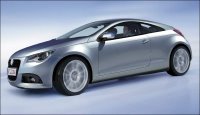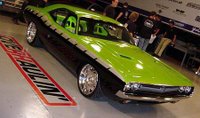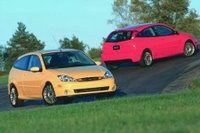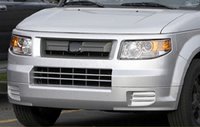2009 Volkswagen Scirocco
After months of internal struggles and arguments over its design, Volkswagen officials have finally given the low-slung Scirocco coupe the green light. Arguments over the car were heated: On one side were the pfennig-pinchers aiming to save cash; on the other, VW boss Wolfgang Bernhard and his plan to resurrect one of the most evocative models in the company’s history. The score thus far: Car Guys, 1; Bean Counters, 0.
Depicted in this series of computer-generated images, the new Scirocco goes into production in early 2008 and on sale in North America by the end of that year as a 2009 model. Information for the illustration was pried from VW’s Wolfsburg-based design studio. AutoWeek sources suggest prices for a base four-cylinder front-drive edition will start at E22,000, or nearly $28,000 and rise accordingly. The top model will have a 3.6-liter V6 and all-wheel drive.
While it would have been easy to tap into Scirocco’s design heritage to launch this renaissance, Volkswagen instead chose a contemporary look. Though it boasts a family resemblance to the Golf (Rabbit), this Scirocco’s shallow side glass and wide stance are similar to the Giorgetto Giugiaro-designed original launched in 1974.
Detailing, though, is borrowed from the low-slung EcoRacer concept unveiled at last year’s Tokyo show, with tautly drawn surfaces, a steep windshield rake and short overhangs. Sources say the three-door hatchback stretches to around 167.3 inches—or 1.8 inches longer than today’s Golf—with width and height at 70.5 inches and 54.7 inches, respectively.
Taking a page from Audi’s book, design boss Murat Gunak created a distinctive grille (maw?) that replaces the V-shaped one on current VWs. Other features include prominent shoulder- and beltlines to avoid a slab-sided look. Scirocco will be offered only as a coupe, though VW toyed with the idea of a convertible; buyers will have the option of a full-length sunroof.
Scirocco’s cabin strives for a sportier look while borrowing switchgear, seats and other bits from other VWs. One option: advanced 3D navigation with software from Internet giant Google.
More an image booster than a volume seller, the Scirocco’s business case calls for sales of no more than 150,000 cars over a six-year life—or just 25,000 per year. Insiders admit that figure is conservative and say it could sell in much higher numbers, particularly if it takes off in the United States.
The new Scirocco is built on the PQ35 platform that is underneath the Golf, with much of the hardware altered to appeal to the ride-and-handling expectations of coupe buyers. The Scirocco gets wider tracks and a MacPherson strut front and multilink rear suspension with specific settings.
Word in Wolfsburg says Scirocco may adopt some lightweight aluminum parts from the second-generation Audi TT. Steering assist is electrohydraulic, though drivers can expect sharper responses than those found in existing Volkswagens.
The entry-level model will likely get the just-introduced supercharged and turbocharged 1.4-liter Twincharger four from the Golf GT. It pumps out 140 hp to 170 hp, depending on tuning. Above that, a turbocharged 2.0-liter like that in the GTI can be massaged to deliver in the region of 230 hp, as hinted at on Volkswagen’s Edition 30 concept. A 2.0-liter diesel four will also slide into the engine bay, but that oil burner probably won’t come to the United States.
Volkswagen also plans a Scirocco 4Motion flagship, probably later rather than at the initial launch of the model. Expect it to use the new 3.6-liter 15-degree V6 with 280 hp. Transmission choices will include a standard six-speed manual, with the popular double-clutch DSG unit an option.
Volkswagen will build the Scirocco in Portugal on the same line as the coming Eos. The two cars share a basic mechanical package, and with key suppliers having established satellite operations on site, sources claim the new coupe can be produced more cheaply and with the same quality as in Germany.
Before the car goes into production, Volkswagen intends to streamline processes to ensure profits. Call that a nod to the accountants. If reports in Germany are believed, VW now loses money on every Golf it produces at home. That’s something product boss Bernhard intends to reverse—and soon.
FUTURE VOLKSWAGEN
Our moles not only gave up the goods on the new Scirocco, they also dug up what else Volkswagen is doing to fill out its future lineup. After Rabbit and Eos later this year, here’s what’s coming from Wolfsburg:
2006
Touareg: Facelifted, the SUV offers a 3.6-liter 280-hp V6 gas engine. U.S. sales start by fourth quarter
Cross Golf: Off-road-inspired model addition
2007
Golf Wagon: New Jetta-based load hauler
Compact SUV: Production version of Concept A show car offered in front- and four-wheel drive. Big things are expected by the home office for this in the United States
Minivan: Joint-venture seven-seater built alongside upcoming Chrysler minivans in Canada
2008
Polo: Fifth-generation subcompact hatch under development with eye toward possible sales as entry-level U.S. model. Three- and five-door hatch and sedan versions planned
Scirocco: See main story; produced in Portugal alongside Eos
Golf/Rabbit: Sixth-generation, Europe’s perennial best-seller overhauled in a bid to make it cheaper to produce and boost VW’s bottom line
Passat coupe: Mercedes-Benz CLS fighter with a sleek coupe profile and four-door layout will be built alongside the (facelifted for 2008) sedan and wagon
2009
Touran: Golf-based compact MPV renewed. Possible U.S. entry
Jetta: Sixth incarnation of VW’s compact sedan. The U.S. version may ditch costly multilink rear suspension for a return to torsion beam. Production stays in Mexico
Polo MPV: Subcompact, unlikely to head Stateside
Polo cabriolet: Affordable cloth roof convertible with two-plus-two layout. Possible starter for North America
Touareg: Second-generation SUV developed in joint venture with Porsche (Cayenne) and Audi (Q7). Adds gasoline-electric hybrid model, direct injection for V6 and V8. W12 replaced with conventional V12 by Audi
Phaeton: Second-generation upmarket sedan; will VW try to interest Americans again?
Source Auto-Week
 Not much is known about this all-electric Audi concept called the R-Zero except that it's the brain child of three design student: Pierre-olivier
Not much is known about this all-electric Audi concept called the R-Zero except that it's the brain child of three design student: Pierre-olivier






























